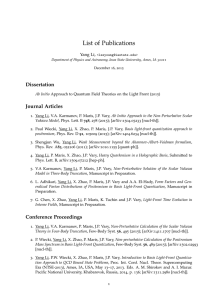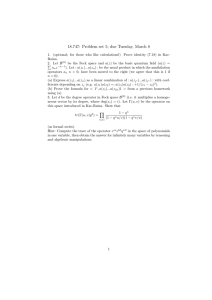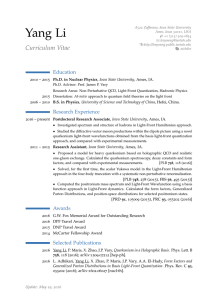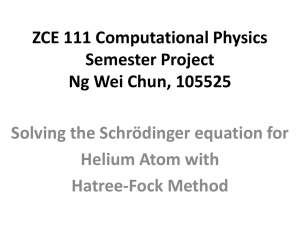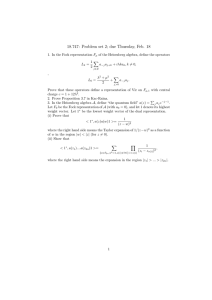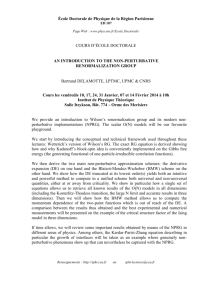Research Statement Yang Li,
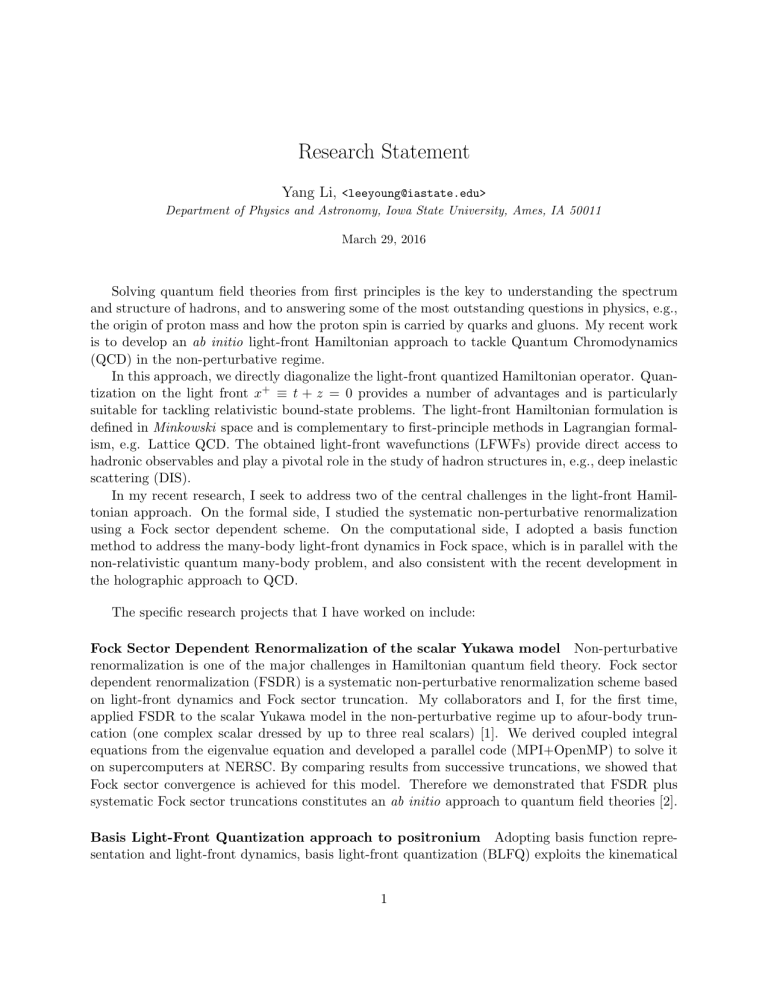
Research Statement
Yang Li,
<leeyoung@iastate.edu>
Department of Physics and Astronomy, Iowa State University, Ames, IA 50011
March 29, 2016
Solving quantum field theories from first principles is the key to understanding the spectrum and structure of hadrons, and to answering some of the most outstanding questions in physics, e.g., the origin of proton mass and how the proton spin is carried by quarks and gluons. My recent work is to develop an ab initio light-front Hamiltonian approach to tackle Quantum Chromodynamics
(QCD) in the non-perturbative regime.
In this approach, we directly diagonalize the light-front quantized Hamiltonian operator. Quantization on the light front x
+ ≡ t + z = 0 provides a number of advantages and is particularly suitable for tackling relativistic bound-state problems. The light-front Hamiltonian formulation is defined in Minkowski space and is complementary to first-principle methods in Lagrangian formalism, e.g. Lattice QCD. The obtained light-front wavefunctions (LFWFs) provide direct access to hadronic observables and play a pivotal role in the study of hadron structures in, e.g., deep inelastic scattering (DIS).
In my recent research, I seek to address two of the central challenges in the light-front Hamiltonian approach. On the formal side, I studied the systematic non-perturbative renormalization using a Fock sector dependent scheme. On the computational side, I adopted a basis function method to address the many-body light-front dynamics in Fock space, which is in parallel with the non-relativistic quantum many-body problem, and also consistent with the recent development in the holographic approach to QCD.
The specific research projects that I have worked on include:
Fock Sector Dependent Renormalization of the scalar Yukawa model Non-perturbative renormalization is one of the major challenges in Hamiltonian quantum field theory. Fock sector dependent renormalization (FSDR) is a systematic non-perturbative renormalization scheme based on light-front dynamics and Fock sector truncation. My collaborators and I, for the first time, applied FSDR to the scalar Yukawa model in the non-perturbative regime up to afour-body truncation (one complex scalar dressed by up to three real scalars) [1]. We derived coupled integral equations from the eigenvalue equation and developed a parallel code (MPI+OpenMP) to solve it on supercomputers at NERSC. By comparing results from successive truncations, we showed that
Fock sector convergence is achieved for this model. Therefore we demonstrated that FSDR plus systematic Fock sector truncations constitutes an ab initio approach to quantum field theories [2].
Basis Light-Front Quantization approach to positronium Adopting basis function representation and light-front dynamics, basis light-front quantization (BLFQ) exploits the kinematical
1
symmetries of relativistic dynamics as well as the similarity between light-front dynamics and the non-relativistic quantum many-body problems. It also incorporates features of light-front holographic QCD. My collaborators and I applied the BLFQ approach to positronium [3]. This is the first BLFQ application to a bound-state system and it serves as a benchmark test. We truncated the Fock space and derived a two-body effective Hamiltonian implementing the one-photon exchange. We obtained the positronium mass spectrum at a strong coupling α = 0 .
3, and studied in detail the regulator dependence. The resulting spectrum is in good agreement with the standard quantum mechanical results including O ( α
4
) QED corrections.
In addition to the spectroscopy, I also calculated the electromagnetic form factors, the generalized parton distributions (GPDs) and the impact parameter dependent GPDs for positronium [4].
These applications serve as prototypical examples for visualizing hadrons in 3 dimensions.
BLFQ approach to heavy quarkonium Based on the success of the positronium calculation, I applied the BLFQ approach to heavy quarkonium [5]. I adopted a confining interaction from lightfront holographic QCD. I proposed a longitudinal confinement consistent with the pQCD parton distribution, and extended the holographic confinement to the heavy flavors. I also implemented a realistic one-gluon exchange in light-front dynamics. I obtained the charmonium and bottomonium mass spectra by diagonalizing the Hamiltonian.
The resulting LFWFs were used to compute decay constants and elastic form factors. Our results are in good agreement with the available experimental measurements as well as other established methods (e.g., Lattice QCD).
Diffractive vector meson productions We apply our BLFQ calculation of heavy quarkonium to deep inelastic scattering (DIS) and study the diffractive vector meson productions in electronproton ( ep ) collision within the color dipole picture [6]. These production processes are closely related to the proposed experiments at, e.g. Electron Ion Collider (EIC), and will serve as a quantitative tool for small Bjorkenx physics, provided theoretical progress reduces model dependence.
Our approach provides access to vector meson LFWFs over the entire spectrum with only a few parameters, connecting also with the mass spectrum, decay constants and other hadronic observables. Our results will help to discern the advantages and limitations of the competing dipole models. On the other hand, comparison with the experimental measurements will also provide a stringent test for our model over a dynamical range complementary to the initial tests from the mass spectroscopy and decay constants.
FSDR and BLFQ represent exciting recent developments in the ab initio approach to nonperturbative QCD. Looking further ahead, I expect that continued work in related directions will be fruitful and of broad interest. Beyond these familiar areas, I am also eager to learn new methods and explore new areas by joining new projects.
My concrete plans for future research work are:
Light-Front Hamiltonian approach to hadrons I will extend the BLFQ approach to heavy quarkonium to heavy-light mesons, light-light mesons and baryons, and expect fruitful results. I also plan to include sea quarks to study the mesons above the threshold as well as the exotic states.
My ultimate goal is to build a systematic non-perturbative computational framework, implementing the basis light-front quantization approach, to study properties of hadrons from first principles.
2
The obtained LFWFs provide direct access to a wide range of hadronic observables. I plan to use them to compute the generalized parton distribution (GPDs), the transverse momentum distributions (TMDs) and the gravitational form factors. These quantities offer a tomography of hadrons and are the major foci of the forthcoming experiments at, e.g., EIC and LHC.
I will continue the study of diffractive vector meson production in electron-proton, electron-ion and ultra-peripheral heavy ion collisions, which would provide distinct measurements of the gluon distribution in protons and nuclei at small Bjorkenx in the current and future facilities.
Non-Perturbative renormalization In the future, I plan to apply the powerful FSDR scheme to the bound-state problem in the scalar Yukawa model. Within the FSDR approach, all parameters of the bound-state system have been fixed and properly renormalized from the the single-particle sector. By solving the eigenvalue equation, we will naturally take into account all contributions allowed by the Fock sector truncation, including, but not limited to, the self-energy, ladder, crossladder and stretched box contributions. By comparing successive truncations, we can assess the convergence of the Fock sector expansion. The obtained LFWFs can be used to improve, e.g., deuteron spectator tagging at a future Electron-Ion Collider.
In parallel to the investigation of the scalar Yukawa model, I also plan to apply FSDR to Yukawa model and QED. Studying these models will provide valuable insights to strongly interacting relativistic bound states. These explorations will also lay a solid foundation for tackling QCD. The current approach can also be used to solve effective field theories non-perturbatively retaining full relativity.
References
[1] Yang Li, V.A. Karmanov, P. Maris, J.P. Vary, Few-Body Syst.
56 , 495 (2015).
[2] Yang Li, V.A. Karmanov, P. Maris, J.P. Vary, Phys. Lett. B 748 , 278 (2015).
[3] P. Wiecki, Yang Li, X. Zhao, P. Maris, J.P. Vary, Phys. Rev. D 91 , 105009 (2015).
[4] L. Adhikari, Yang Li, X. Zhao, P. Maris, J.P. Vary and A.A. El-Hady, Submitted to Phys. Rev. C, arXiv:1602.06027 [nucl-th].
[5] Yang Li, P. Maris, X. Zhao, J.P. Vary, Submitted to Phys. Lett. B, arXiv:1509.07212 [hep-ph].
[6] G. Chen, Yang Li, P. Maris, K. Tuchin, J.P. Vary, X. Zhao, Manuscript in Preparation.
3
